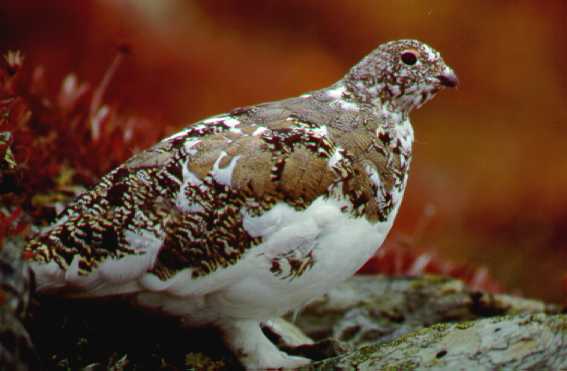Ptarmigan - White Tailed
Mountain Quail, Mountain Partridge, Mountain Chicken, Mountain Grouse Scientific Name: Lagopus leucurus
Mon, 30th June, 2025 - 9:16 pm GMT
Sponsor Ads:

Alternative Name
Mountain Quail, Mountain Partridge, Mountain Chicken, Mountain Grouse Scientific Name: Lagopus leucurusBasic Info
At maturity, a White Tailed Ptarmigan can weigh between ten ounces and one and a half pounds (350 grams). Their bodies are rather stocky. The tails of White Tailed Ptarmigans are quite short. They are, obviously, white. They have rounded, white, short wings and feathers on their toes. These feathers aid in the White Tailed Ptarmigan's survival in snowy areas. In the winter, the White Tailed Ptarmigan acquires white plumage over its entire body. Warmer months find the White Tailed Ptarmigan adorned in brown marked plumage. The brown coloration shows dark or black stripes. Males have red combs over their eyes, which are used for territorial displays and courtship rituals. The red combs of females are less obvious, and may not be easily seen.
Health
Because White Tailed Ptarmigans eat a variety of fresh green vegetation, insects, and berries in the wild, they should be fed a similar diet in captivity. Breeding Soon after the winter snow melts, the White Tailed Ptarmigan builds a nest on the ground in which it lays between five and 14 eggs. Breeding usually occurs between 900 and 1,200 meters. These will be incubated for about 21 days. The female cares for the young White Tailed Ptarmigans, who can fly by the time they are eight to ten weeks old. Chicks eat diets that consist mainly of insects in order to obtain lots of protein.Habitat
Most northern states southward to northern New MexicoBehavior
With seasonally changing color, the beautiful White Tailed Ptarmigan inhabits very cold, harsh climes that many animals would have a difficult time surviving. These birds thrive in the arctic regions they live in. The White Tailed Ptarmigan are most often found in cold, northern areas, especially arctic or tundra areas. They especially like rocky ridges near the snow line, and may be found at higher altitudes than other ptarmigan species. In spring, males become territorial and begin to establish home ranges that they defend from other males. Generally, screaming vocalization and short flight are the defense techniques used. After breeding and the raising of a clutch, White Tailed Ptarmigans form flocks. They become nomadic in winter and fall, though they rarely migrate more than 150 miles from their home ranges. White Tailed Ptarmigans will return in large flocks to their breeding grounds, though once they have reached these areas, solitary breeding behavior resumes.This species usually lives 3 to 5 years in the wild, but wil often live between 13 and 15 years in captivity.Origin
North AmericaHistory
White Tailed Ptarmigan are found in North America, where they range from the most northern states southward to northern New Mexico. Although White Tailed Ptarmigan are preyed upon by raptors and carnivorous mammals, human hunters are also a threat to these birds. Domestic sheep have been allowed to graze over much of the White Tailed Ptarmigan's southern range, effectively ruining much of this land and reducing the White Tailed Ptarmigan's habitat.Common Foods
When available, White Tailed Ptarmigans prefer to eat berries, flowers, young leaves, other vegetation, and insects like caterpillars and beetles. In winter when such foods are not available, these birds eat bark, pine needles, winter berries, and seeds.Sponsor Ads:
If you try to please everybody, nobody will like it. -- Unknown
Ptarmigan - White Tailed
Coded by: BGID® | ALL RIGHTS RESERVED Copyright © 2000-2025
Disclaimer | Privacy | Report Errors / Contact | Credits
















